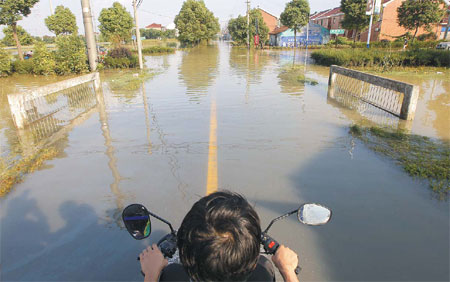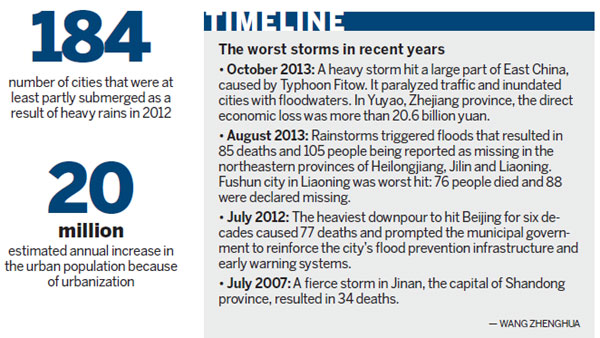Closing the floodgates to disaster
Updated: 2013-11-01 07:54
By Wang Zhenghua (China Daily)
|
|||||||||||
Experts are calling for improvements to drainage systems and emergency response capabilities to prevent China's larger cities from being paralyzed by adverse weather, as Wang Zhenghua reports from Shanghai.
Early in October, a heavy storm ravaged a large swathe of East China as Typhoon Fitow swept across the region. At least 70 percent of Yuyao city in Zhejiang province was submerged under deep floodwaters that left the city of 1.3 million people paralyzed as power supplies, telecoms, tap water and public transport services were crippled. Even the local TV and radio stations were unable to broadcast.
 |
|
A bridge leading to Guomu village in suburban Yuyao city, Zhejiang province, submerged by floodwater after Typhoon Fitow hit East China in early October. Gao Erqiang / China Daily |
Even though 20 days had passed since the unexpected flood hit Yuyao, Chen Zhenglan was still haunted by memories of the nightmare during which the city was thrown into complete chaos and her family, along with many others, was cut off from food and clean water for days.
Luckily, no deaths or casualties were reported, but an official report estimated the economic loss to the city at more than 20 billion yuan ($3.2 billion).
Residents accused the regional government of lacking the experience and foresight required to respond to such a disastrous situation.
"We should all learn a lesson from that flood," said Chen.
A serious threat to life
Yuyao, a dazzling industrial city in northeastern Zhejiang, is the latest indication of the vulnerability of some Chinese cities when faced with storm-generated floods.
In 2012, 184 cities - including some at county-level - were at least partly submerged as a result of heavy rains, according to the State Flood Control and Drought Relief Headquarters. In 2011, the number was 136, while in 2010 it was 269.
 |
Research conducted by the Ministry of Housing and Urban-Rural Development shows that even cities prone to drought - for example, Shenyang in the northeastern province of Liaoning and Xi'an in Shaanxi province in the northwest - are becoming increasingly waterlogged as a result of heavy storms.
Not only do flash floods cause immense damage to city infrastructures and the residents' property and livelihoods, but they also pose a serious threat to life.
In July last year, 79 people died as a result of the heaviest downpour to hit Beijing for 61 years. Millions of residents were affected and thousands were evacuated from their homes, leading to an economic loss of as much as 10 billion yuan.
Dealing with climatic extremes will remain a major challenge for cities as China moves forward on the path of urbanization, and it will take time for regional governments to remedy their defective drainage networks, according to officials and experts at the 2013 International Forum on Urban Flood Control held in Shanghai in mid-October.
It's estimated that the urban population will continue to rise by 20 million every year as the urban areas to expand. The international consultancy, McKinsey & Co, estimates that by 2025 China will have 10 to 12 mega-cities with populations of 15 to 20 million, and many more city clusters will arise in due course.
Studies have shown that the design of cities can cause the volume of rainfall to increase and lead to storms occurring more frequently.
According to Zhang Jianyun, president of the Nanjing Hydraulic Research Institute, compared with the period between 1961 and 1980, the number of days of heavy rainfall in the urban areas of Suzhou in Jiangsu province rose by 30 percent between 1981 and 2010. In Nanjing, the figure was 22.5 percent, while Ningbo, in Zhejiang, saw 32 percent. In contrast, the increase was significantly slower in the eastern region's inland areas.
The lack of adequate drainage networks to handle stormwater caused by heavy, prolonged rainfall is one of the primary causes of waterlogging in cities, according to the experts.
In developed economies, excess water left by heavy downpours is dealt with by a dual system that consists of traditional pipelines to handle regular downpours, coupled with a major drainage network, featuring both above ground and subterranean water retention facilities, that deals with the water left by severe storms.
These countries have also developed stormwater management practices that reduce the impact on built-up areas and promote the natural movement of water within an ecosystem or watershed.
Related Stories
Decree issued on urban drainage and sewage treatment 2013-10-16 19:37
China to upgrade urban drainage systems 2013-07-13 20:39
Cities urged to step up drainage improvements 2013-04-03 01:44
Today's Top News
Firms heading home as benefits wane in China
US urged to explain phone taps
Disclosure of WTO report rebuked
Vaccine gets nod for global use
Freer RMB 'can answer US claims'
'Dangerous provocation' condemned
Promoting baby formula prohibited in hospitals
Police told to protect medical workers
Hot Topics
Lunar probe , China growth forecasts, Emission rules get tougher, China seen through 'colored lens', International board,
Editor's Picks

|

|

|

|

|

|





